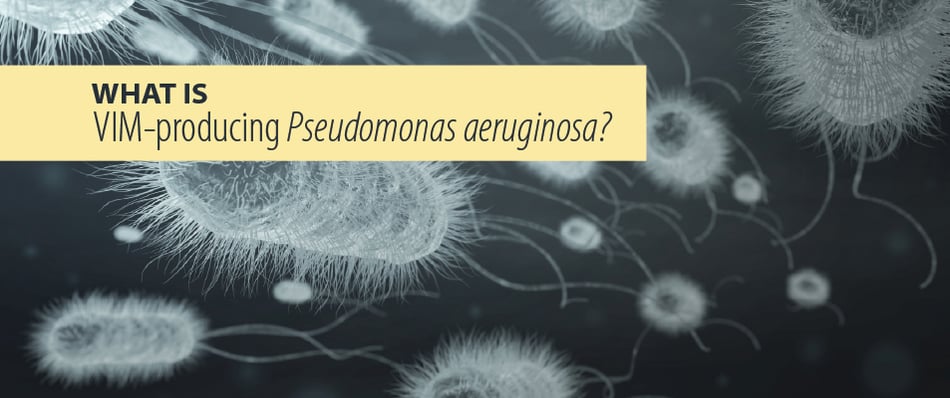What is VIM Pseudomonas aeruginosa?

In this blog, we have covered the dangers of Pseudomonas aeruginosa, a bacteria whose resistance to antibiotics has led it to be named one of the greatest threats to humans by the World Health Organization. In today's post, we'll look at one particular strain which produces an enzyme that can break down the most powerful antibiotics, making it especially lethal. This strain is knows as VIM-producing Pseudomonas Aeruginosa.
What is Pseudomonas aeruginosa, or P. aeruginosa?
This bacterium is commonplace, found in soil, water, plants, on animals and on us. It is encapsulated, which means it is covered in a thick layer of polysaccharide which allows it to evade efforts of our innate immune system. It is also Gram-negative, meaning that its outer layer (in addition to its encapsulated layer) does not absorb material from its environment as easily, including antibiotics. With these two attributes, P. aeruginosa has already stymied our two greatest efforts at killing it, our immune system and antibiotics.
What is VIM-producing P. Aeruginosa?
VIM stands for Verona integron-encoded metallo-β-lactamase. Let's unpack those words.
- An integron is a segment of DNA that can acquire and integrate new genetic material into its genome. The new genetic material is carried by small, mobile pieces of DNA called cassettes. In the cassettes, these bits of DNA can't create proteins. Integrons grab the DNA from the cassettes and copy them into themselves, where they can start making protein, including enzymes. Enzymes are the catalysts of biology, meaning they speed up chemical reactions including breaking down biological structures. Where do these mobile segments of DNA come from? The environment. P. aeruginosa is able to grab DNA from other living bacteria cells and even floating DNA released by dead bacteria in a process called horizontal gene transfer.
- The Verona integron gene (first identified and described in a patient sample from Verona University Hospital in Verona, Italy). This particular integron grabs DNA that produces the enzyme that breaks down carbapenem, a class of last-resort antibiotics.
-
Metallo-β-lactamase (MBL) is an enzyme produced by bacteria that can break down antibiotics by using zinc (metal) to break down the beta-lactam ring in antibiotics such as penicillin, cephalosporins, and carbapenems. There are several known MBLs, including VIM. VIM breaks dow
ncarbapenems.
Now that we have broken down the name of this deathly superbug, let's look at the destruction it leaves in its wake. From 13-19% of HAIs are caused by a strain of P. aeruginosa, which are resistant but can be cured with the right antibiotics. Still, P. aeruginosa has a mortality rate of around 18%. However those with the VIM genes are notably lethal, since antibiotics of last resort are not an option. Mortality rates for VIM P. aeruginosa (VIM-PA) are around 30%, with some variability depending on the location of the infection.
How to patients get exposed to P. aeruginosa or VIM-PA? A recent study showed that almost 90% of transmissions were due to a contaminated environment, with only 13.7% coming from cross-transmission (hands). Because P. aeruginosa and VIM-PA are effective biofilm producers, this bacteria can evade standard disinfection protocols, becoming exceptionally dangerous in an ICU environment with vulnerable patients.
How does P. aeruginosa spread? Typically, ICUs receive more careful cleaning, but bed rails are among the surfaces most overlooked (along with ventilator buttons). Left alone, P. aeruginosa can thrive in these reservoirs. Other surfaces that present ideal environments for survival and horizontal gene transfer are sinks and water systems. Sinks provide the moisture as well as the access to other bacteria to develop resistance, and sinks also provide the means for dispersal, with every splash spreading bacteria up to 3 feet from the source. Once P. aeruginosa is present in a sink or water system, it can be incredible difficult to remove, sometimes requiring the complete removal of sinks and water systems. In fact, P. aeruginosa can colonize our bodies as well, making patients over 6 times more likely to get a recurrent infection once colonized.
So basically... P. aeruginosa not only evades our immune system, it breaks down antibiotics. VIM P. aeruginosa adds to this danger by being able to break down our most powerful antibiotics, carbapenems. While it is thankfully not the most common strain of P. aeruginosa, it's mortality rate makes it especially dangerous in healthcare settings.
What can we do about P. aeruginosa? Adherence to cleaning and hand hygiene protocols are always important. Preventing dangerous strains of P. aeruginosa, however, means making sure that no surface allows bacteria to survive long enough to share dangerous genes and become resistant. For this, the integration of biocidal materials is essential. Bed rails, sinks, and work surfaces made from copper-impregnated materials means that an bacterial contamination, including P. aeruginosa and any bacteria it may steal genes from, is dead within 2 hours. These surfaces provide a necessary safety net in the most critical healthcare spaces, including critical care and ICUs.
![EOScu Logo - Dark - Outlined [07182023]-01](https://blog.eoscu.com/hubfs/Eoscu_June2024/Images/EOScu%20Logo%20-%20Dark%20-%20Outlined%20%5B07182023%5D-01.svg)




